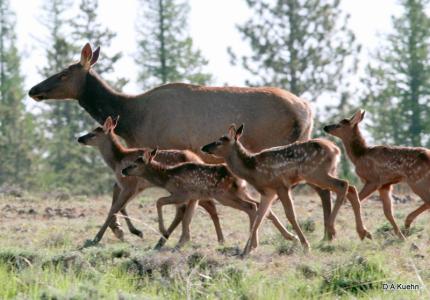How to find priority habitats and species locations

The most common way people find information about known locations of priority habitats and species in Washington is by using the Priority Habitats and Species (PHS) on the Web app. Simply navigate to your area, select a project site, and generate a PHS report to show the priority habitats and species near your project site. This online app gives landowners and developers information they need to conserve habitat and species. Many local governments use this app when reviewing development proposals.
Learn how to use the PHS on the Web app.
The second way to get PHS data is geared to GIS users who want data for a specific area of interest. This method is helpful for GIS users who want to evaluate PHS locations in relation to other GIS layers. To get digital PHS data, GIS users have two paths, depending upon if sensitive data (explained below) is involved. GIS users who want sensitive data must sign a formal PHS Release Agreement. To start this process, use the Sensitive PHS Data Request Form. GIS users whose area of interest does not involve sensitive information use the Non-Sensitive PHS Request Form.
"Sensitive" PHS data
In keeping with the Public Records Act (RCW 42.56.430(2)), the department designates some fish and wildlife data as "sensitive" (confidential) due to an increased risk of human interference. The precise location of sensitive species is not disclosed to the public. Public maps and PHS on the Web show these locations generalized to the township or section. The law authorizes the department to share sensitive data with landowners, government agencies, tribes, and university researchers, but only under a formal data sharing agreement.
How to use PHS information
When PHS records are found in a project area
Contact your local WDFW habitat biologist and local planning department to discuss your project. Arrange a site visit with a biologist to review your project area. They can help you plan your project to avoid and minimize harm to priority habitats and species. If impacts are unavoidable, offsetting the harm starts with quantifying the impact (e.g., acres of tree removed, square feet of clearing). With this information, a biologist can then help you determine appropriate mitigation. Learn ways to minimize harm to affected habitats or species in WDFW’s science-based PHS Management Recommendations.
If your project area is under a mask for a sensitive species, your local WDFW habitat biologist can let you know whether your project will harm sensitive species.
When no PHS records are found in a project area
Finding no PHS records means either a biologist has not surveyed the area, or no priority habitats and species are present. PHS data is added to the map after field-verification by WDFW biologists or a WDFW-verified professional. There are also some wide-ranging habitats such as riparian, nearshore, in-stream, and snags and logs that are not mapped throughout the state but may exist on the project site. If you think your project site might have unidentified priority habitats or species, call your local WDFW habitat biologist or another professional biologist to complete a site survey.
Map limitations
Although mapped PHS data is useful for determining the general extent of priority species or habitats, the department has not surveyed the entire state of Washington. PHS map data is meant to serve as a starting point to identify priority habitats and species. It is not meant to replace or preempt more detailed field-based, site-level mapping. Site-specific surveys are usually needed to rule out the presence of priority habitats or species. PHS maps do not provide an official agency determination of the potential impacts of a specific project to fish and wildlife.
Other Sources of Information
Maps of at-risk plant species are available from the Department of Natural Resources Natural Heritage Program.
Use the US Fish & Wildlife Service’s IPaC for projects that involve federal environmental review.
Contact
Your local WDFW habitat biologist can provide site-specific advice.
Please contact PHS customer service staff at PHSProducts@dfw.wa.gov or 360-902-2543 for assistance with Sensitive PHS Data Requests and Non-Sensitive PHS Data Requests.